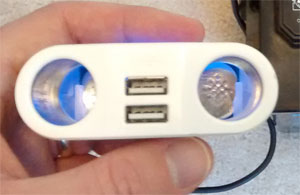 Turning an RV marine battery into a massive 12-volt emergency power source
Turning an RV marine battery into a massive 12-volt emergency power source
 Every fall, I take the deep-discharge marine battery out of the pop-up camper and put it safely in the basement for winter storage. I’ve never used it for ham radio purposes, mostly because I’ve never needed it and it’s tied up for most of the summer.
Every fall, I take the deep-discharge marine battery out of the pop-up camper and put it safely in the basement for winter storage. I’ve never used it for ham radio purposes, mostly because I’ve never needed it and it’s tied up for most of the summer.
Recently we had a “long-ish” power outage (not uncommon during snowy, windy Maine winters). While we had plenty of heat from the fireplace, it didn’t take long for the batteries in our various phones and tablets to kick the bucket.
Luckily, Verizon’s data network is very robust and almost never goes down — even during extended power outages. Other than listening to the local ham radio repeaters and public safety scanner traffic, we rely on Internet access to check on power restoration and keep track of the weather.
I figured it was time to put that unused high-capacity battery to some good use in the off-season.
I decided to order a 12-volt plug socket with eyelet terminals. There were quite a few choices on Amazon but the reviews of the NOCO GC018 struck me as particularly good and I didn’t have to wait for it to arrive from China. The price was right at just under $7 shipped (with Prime) and 232 great reviews didn’t hurt, either.
I wasn’t familiar with the NOCO brand, but what immediately impressed me was how well made it was. It feels like it will last awhile and the connections are very solid. The 3/8″ eyelets aren’t flimsy and they’re low-set to minimize bending. Unlike other options, it has an in-line 15A blade-type automotive fuse which I usually keep on hand. The fuse is well-protected from moisture and the socket has a durable end cap.
I wouldn’t plug a 100w HF rig into the socket, but a 25w mobile radio should’t draw more than 10 amps. A small “pocket-sized” 175-watt inverter would work great with this setup.

To create my charging hub, I used a little Bestek splitter with two 12v sockets and two 5v USB outlets (one 1.0A, the other 2.1A). I would’t use it to power anything with a substantial current draw, but it works great for charging multiple low-power devices. While a 12-volt cigarette lighter socket isn’t the best connector around, it’s the defacto standard for 12-volt consumer devices. Just don’t charge the deep-discharge battery indoors!

My rough math says the battery should be good for well over 150 hours of continuous phone charging. That should last us for most any power-free scenario short of complete and utter societal breakdown — and if that’s the case, I probably won’t be needing my cell phone!
What does your household emergency power setup look like?














Nice Article
Living in a hurricane prone zone, plus tornados, my emergency power is solved by a 6kw genset, 3.5 kw genset, and 2 deep cycle batteries under continual managed charge.
i have nine solar panels with a controller charging a 950 cranking amp marine bat. with 6 separate cells i use my amateur rigs [mainly 2 meter 50 watt..] and 12 volt light bulbs ……also have a back-up 6 amp charger hooked in line if needed…
I use those Dc-Dc boost converters (“600 watt”). Laptop & 12 VDC Computers & some electronic equipment shuts down or at least operates poorly if the voltage gets below 11 VDC.
It only takes using about 10-20% of a lead / acid batteries capacity (amp hour rating) to get that voltage drop to 11 VDC. A lot of amps left in the battery but the voltage is too low for some equipment. The boost converter lets you suck the battery voltage down to 8-9 VDC and use up to about 50-75% of the batteries full capacity. (look up lead acid battery voltage drop discharge curve).
My radio equipment uses about 250 watts (about 20 Amps at 12 VDC), intermittently on transmit. That doesn’t heat the converter up much just briefly running at the max rated input amperage. You can run two converters in parallel for more power. They are cheap enough at $12-15 on Ebay, cheaper and not as heavy as getting more or bigger batteries.
You should study on DC-DC boost converters some to understand the max ratings. Basically the greater the input to output voltage differential the more input current it takes and soon reaches the converters max input current rating.
Drawing voltage just directly off the battery with no converter is not a problem running incandescent lights, fans, air / water pumps or heat elements with the reduced voltage. The lights stay on just get dimmer, a 12 volt fan just blows less, pumps slow down and a heat element doesn’t get quite as hot until you finally suck the bottom out of the battery.
However, stuff that requires a full 12 volts will very soon shut down. They might make a little RFI noise but it can dealt with.
And another thing…..
People throw away those UPS power supplies because replacing the gel cell batteries in them cost nearly as much as a new UPS. You can get them cheap or free. I wire them up to big external car batteries. They only last about 20-30 minutes on the gel cell battery but can last for hours on big batteries. And they have a built in charger to keep the batteries charged up when AC power is available. That lets me run my 110 VAC stuff in the dark too.